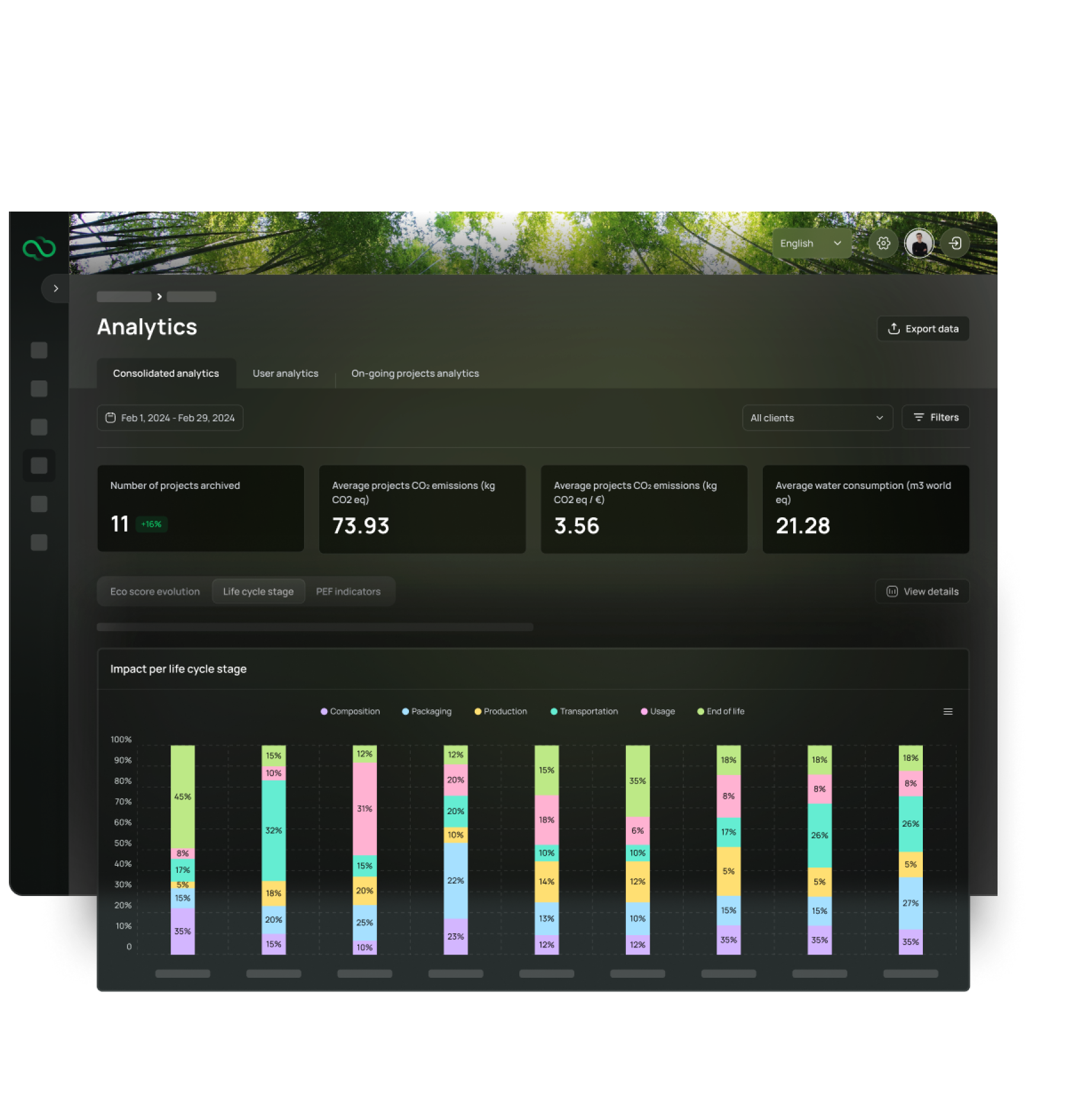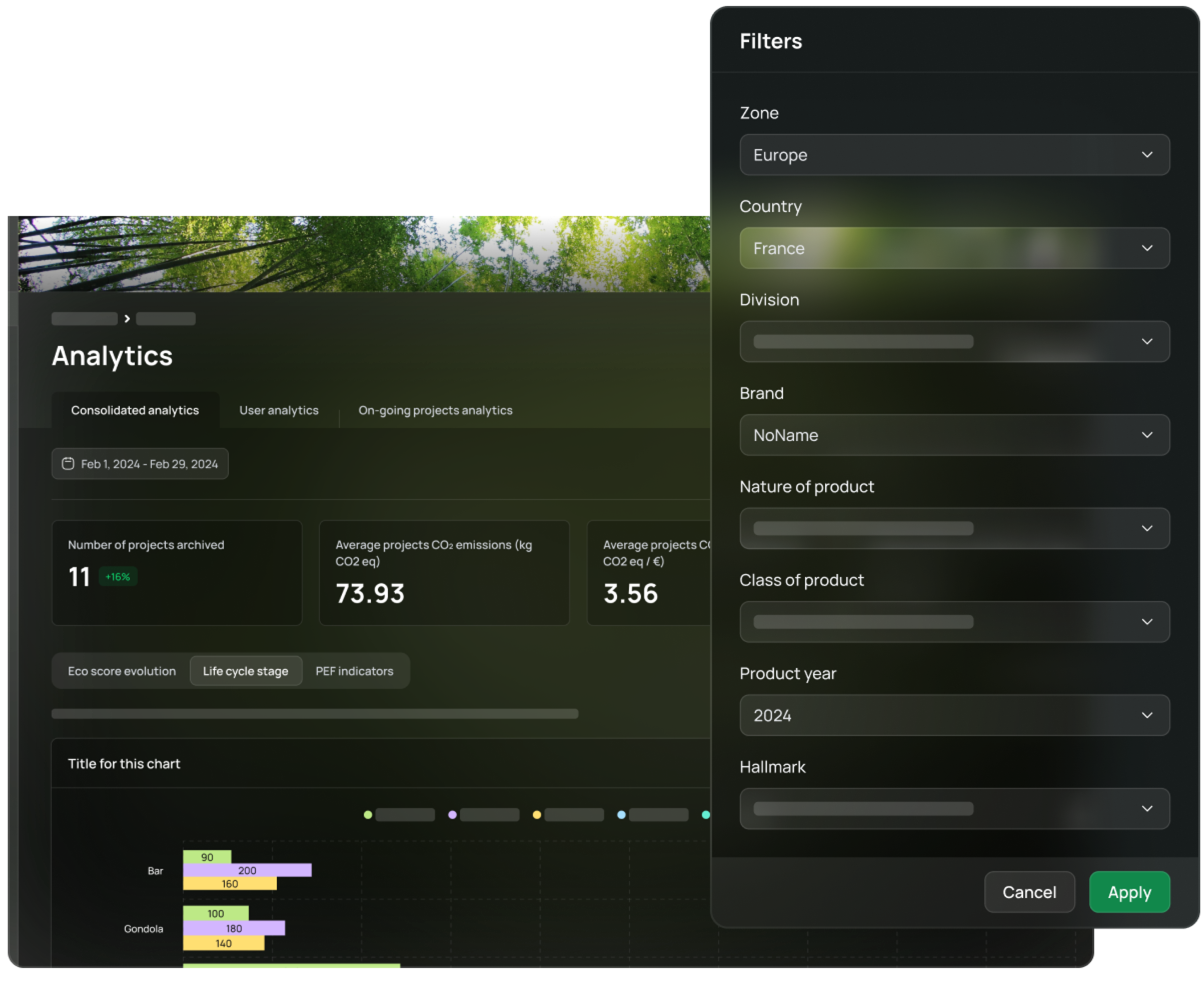New launch offer:
enjoy unlimited eco-scoring & users for a limited time, automatically included in all plans.

Start eco-designing from an extensive product catalog, run what-if scenarios of product-LCAs, and iterate projects based on accurate footprint knowledge to improve your organization's sustainability.
Sustainability By Design
Advanced Analysis of LCAs
Stakeholders Engagement
Real-Time Reporting
EcoDesignCloud is a solution automating complete product life cycle assessments (LCAs) of design choices, enabling businesses to make more sustainable decisions. This includes evaluating materials, production methods, and supply chain logistics to identify the most eco-friendly options. It provides guidance to apply continuous monitoring and improvement, ensuring that sustainability remains an ongoing priority throughout the product life cycle.


With the knowledge of your product footprint from ISO standards methods, you can begin to map out opportunities to reduce your impacts. All this information about your current environmental footprint can help you set viable improvement targets and ensure that you can achieve them. While your teams address customers' expectations in matters of sustainability, you have a set of tools to ensure responsible communication, promote a committed brand identity and comply with regulations.
Ensure a digital transformation with only one tool by integrating a practicale solution for embending ESG practices into your every day operations. EcoDesignCloud is a strategic asset for boosting your company' competitive advantage, and to align your efforts to cut greenhouse gas emissions with recognized climate science.


Now that you have verifiable results on the environmental impacts of each of your product, you can calculate the total footprints of your company. View and manage your sustainability performance by using your integrated Analytics with filters by:
Our platform considers end-to-end corporate value chain activities to give you comprehensive impact measurements, based on globally recognized science methods of ISO 14040/44 Life Cycle Assessment.
Empower your teams to ecodesign products and measure all necessary environmental data, enabling to fully report product sustainability with Product Environmental Footprint (PEF) method, ISO-aligned LCAs, and adapt your product development with responsible practices.

Product Environmental Footprint Methodology Recommended by the European Union
The Product Environmental Footprint (PEF) is an initiative by the European Union designed to standardize the calculations for assessing the environmental impacts of products throughout their life cycles.
The EU's primary objectives are to:
-Measure the environmental performance of products accurately.
-Facilitate effective communication regarding environmental impacts.
The EU's Environmental Footprint methods (EF methods) are currently the most reliable, comparable, and verifiable means of assessing the genuine environmental footprint of a product or organization.
These methods encompass 16 environmental impacts, including climate change and impacts related to water, air, resources, land use, and toxicity. General methods are supplemented by product- or organization-specific calculation rules, allowing for the comparison of environmental performances between similar products and companies operating in comparable sectors.
ISO-Standards of Life Cycle Assessment (LCA)
The LCA method is central to sustainability management, as defined by international standards ISO 14040 & 14044. Life Cycle Assessment is globally recognized for measuring ecological footprints and supporting sustainable development commitments, net-zero journeys, and Science-Based Target initiatives (SBTi).
By using a scientific method directly based on "Cradle-to-Grave" or "Cradle-to-Gate" Life Cycle Assessment projects, you can build your company's sustainable product portfolio and seize opportunities with eco-designed products.
This approach ensures strategic environmental competitiveness for business growth and aligns with EU regulations and policies.
Transparency and Compliance with European standards
As businesses navigate the complexities of modern sustainability demands, the CSRD, ESRS, and EU Taxonomy serve as pillars enhancing transparency, reliability, and comparability in sustainability reporting. These frameworks mandate rigorous double materiality assessments and foster stakeholder engagement, ensuring companies not only comply with regulations but also integrate sustainability into their core operations.
Together, these initiatives provide a solid foundation for sustainable investment, aiding the EU's journey towards climate neutrality and environmental sustainability, ultimately benefiting businesses, society, and the planet.
The connection between the Corporate Sustainability Reporting Directive (CSRD) and the EU Taxonomy lies in their shared goal of promoting transparency and accountability in sustainable finance. The EU Taxonomy provides a classification system for environmentally sustainable economic activities, while the CSRD mandates comprehensive sustainability reporting for companies.
Under the CSRD, companies are required to disclose how their activities align with the EU Taxonomy, ensuring that their sustainability reports are consistent and comparable. This alignment helps investors make informed decisions and supports the transition to a sustainable economy.
The EU framework is designed to assist companies in identifying critical impacts, risks, and opportunities to better manage their climate transition and human rights issues, including those in their value chain. Effective sustainability reporting is crucial for transforming the EU economy towards a sustainable and resource-efficient model, providing essential information to financial institutions, guiding companies, and opening access to sustainable finance opportunities. By applying uniform rules to large European companies and non-EU groups, the framework helps level the playing field against competitors from regions where environmental and human rights violations may be tolerated.
When fully implemented, the ESRS framework will give European companies a competitive edge. However, adopting the EU reporting rules requires substantial changes within companies, including the absorption of detailed technical regulations and the development of robust ESG management systems, often from scratch.
Implementing these standards is essential for achieving a timely and orderly transition to a sustainable economy. Without adequate sustainability information from companies, public and private investments will be misallocated, severely undermining the EU economy's ability to meet climate and nature objectives globally.
The initial step in a company's sustainability reporting is conducting a materiality assessment. According to the general requirements in ESRS 1:
-Companies must report on sustainability matters based on the double materiality principle, encompassing both impact materiality and financial materiality.
-Conducting a materiality assessment is crucial to identify the significant impacts, risks, and opportunities that need to be reported.
The ESRS requires companies to disclose a comprehensive overview of their material impacts, risks, and opportunities. Subsequently, companies should comply with the ESRS disclosure requirements pertinent to their material matters and provide additional entity-specific information as necessary.
The ESRS mandates requirements for the scope of materiality assessments, including the range of sustainability matters to be considered, boundaries, and value chain coverage. It also sets specific criteria for evaluating the materiality of impacts, risks, and opportunities and includes disclosure requirements for the materiality assessment process and its results.
Comprehensive Double Sustainability Reporting
Double materiality is a requirement for companies to be adopted, it is a comprehensive reporting approach considering two critical dimensions: the impact of their business activities on the environment and society, and the effect of environmental and social factors on their financial health.
This dual perspective ensures that companies are not only evaluating their contributions to sustainability but also recognizing how these issues can influence their financial performance.
By integrating these aspects, companies can offer more transparent, relevant, and reliable information to stakeholders, aiding informed decision-making and promoting sustainable business practices.
ESG Conformity & Transparency
Adhering to the Corporate Sustainability Reporting Directive (CSRD) enables companies to produce more reliable and actionable sustainability reports.
By following the stringent standards and requirements of the CSRD, companies can deliver transparent and consistent ESG information. This boosts the credibility of their reports, facilitates better decision-making for stakeholders, and drives more effective and impactful sustainability strategies.
With a holistic approach to PEF analysis, we enable you to make data-driven decisions that contribute to a more sustainable future.

Conduct comprehensive assessment using scientific methods in line with EU climate-related disclosure regulations, based on 16 Product Environmental Footprint (PEF) indicators.
Backed by scientific method throughout a product's life cycle & defined on international norms ISO 14040 & 14044.
Access corporate-compliant environmental disclosure requirements according to the Corporate Sustainability Reporting Directive (CSRD).
According to the European Commission's PEF standard on environmental labeling, we analysize at product-level and provide measurements for 16 impact categories.
Track, understand and manage your company's impact on GHG corporate value chain- Scope 3, following ISO-14040/44 standardized LCAs to identify efficiencies and set your sustainability targets.

"This level of transparency and cooperation can also open up new avenues for innovation".

Antoine Vanlaeys,
Chief Operations Officer,

"We envision this innovation will be widely adopted by the ecosystem as the new norm for the future of luxury retail".

Cyril Chapuy,
President, L’Oréal Luxe

"The EcoDesignCloud tool is a step towards more efficient and accurate environmental impact data-sharing between clients and suppliers".

Mathieu Parfait,
CSR Director at Diam